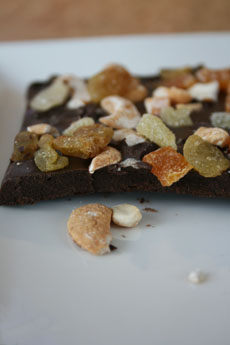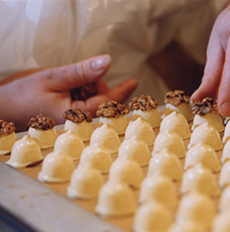 Mendiant from The Barefoot Contessa, available at StonewallKitchen.com. Photo by Hannah Kaminsky | THE NIBBLE. Mendiant from The Barefoot Contessa, available at StonewallKitchen.com. Photo by Hannah Kaminsky | THE NIBBLE.
Last Updated May 2018 |
Product Reviews / Main Nibbles / ChocolateChocolate GlossaryChocolate Terms & Definitions: M
On this page you’ll find terms including marzipan, Mexican chocolate and milk chocolate. If you think we should consider chocolate terms and definitions other than those we have provided click on the Contact Us link on this page. Also enjoy our other 60 food glossaries. Click on a letter of the alphabet to get to another page of the glossary. a b c d e f g h i j k l m n o p q r s t u v w x y z This glossary is protected by copyright and cannot be reproduced in whole or part.
MALTITOLA natural sugar substitute that provides the most natural sweetness in sugar-free chocolate. Made from malt extract, it is more expensive than other non-sugar sweeteners but used in the finer sugar-free chocolates. See our comprehensive article on sugar substitutes. MADAGASCARA growing region and cacao often associated with a vibrant and crisp citrus tartness. Grape and pineapple-like tones are common as well. Vodka and white wine notes sometimes accompanies these flavors. Although not as common, spice, cedar, and other woody tones are appearing in more Madagascan chocolate. It is a slightly lighter style, sharp on the palate but with no bitterness.
MARRONS GLACÉSPronounced mah-RAWN glah-SAY, candied chestnuts (also called glazed chestnuts or crystallized chestnuts). In an elaborate process, cooked chestnuts are are candied in a glucose syrup flavored with vanilla. The glucose creates a crystalline effect that sugar does not.
MEAT MENDIANT MEXICAN CHOCOLATE or CHOCOLATE MEXICANO
MILK CHOCOLATEAlong with white chocolate, the sweetest eating chocolate. Made of chocolate liquor, cocoa butter, some form of milk, sugar, and flavorings. Today, fresh, sweetened, condensed or powdered whole milk, depending on the individual manufacturer’s formula and manufacturing methods, is blended with the sugar and added to the chocolate liquor during the crumb or flake process. It is then dried on heated rollers to produce the flavor more typical of European chocolate or mixed with slightly acidified milk to produce the flavor preferred in the U.S. The milk often brings out cream, caramel or butterscotch flavors in the chocolate. All milk chocolate made in the United States must contain at least 10% chocolate liquor and 12% whole milk (usually in dried form). Bars of fine milk chocolate generally contain between 30% and 45% cacao. The most inexpensively made, commercial cacao can have as little as 5% cacao. Since the higher the cacao content, the more “snap” a bar has, milk chocolate has less snap than dark chocolate. Milk chocolate was first made successfully in 1879 after Daniel Peter*, a Swiss chocolate manufacturer, had the idea to substitute powdered milk for the whole milk or cream that had been unsuccessfully attempted previously. Powdered milk had been invented by his neighbor, Swiss chemist Henri Nestlé, in 1867, after eight years of experiments. So while the Spanish were responsible for bringing cacao to Europe from the New World and Englishman Joseph Fry created the first chocolate bar, the Swiss have full ownership of milk chocolate. Today, the trend among chocolate connoisseurs is toward dark milk chocolate. *Peter was a candle maker who fell in love with and married the daughter of a chocolatier. He converted his candle factory into a chocolate plant—to great success. His original formula using powdered milk is still in use today. In 1879 Peter and Nestlé founded the Nestlé Company. MOCHAThe flavor combination of chocolate and coffee. MOLDED CHOCOLATEChocolate shaped in a mold, including classic treats like chocolate Easter bunnies, Easter eggs, and Santas. Tempered chocolate is poured into a mold, cooled, and unmolded. Molded chocolates can be solid or hollow. Chocolates that are not molded are enrobed. Chocolates that were both molded and filled first appeared in 1913. They were developed by Swiss confiseur Jules Séchaud of Montreux, who created the machine and the process. MOLDINGMolding has two meanings: (1) In the chocolate-making process, after conching, the chocolate is tempered, poured into the molds, passed through the refrigerated tunnel and then unmolded. This creates the large blocks of couverture from which all chocolates are made, and can also create the producer’s individual chocolate bars. The chocolate bars are left to rest for a few days so their flavors will age and to insure stability. Then the chocolate is packaged. (2) In making molded chocolates, the tempered chocolate is poured into molds and the molds are turned so the chocolate creates a fine coat (the shell). The shells are subsequently filled with ganache, praline, whipped cream, or other filling; then closed with a layer of chocolate and cooled. The molds are tapped to remove the finished chocolates. This is known as shell molding. Dipping is one of the four basic methods four basic methods of coating chocolate onto a center such as a caramel, nut or fruit; it was the original method of making coated chocolates and is done by hand by artisan producers. The other methods are enrobing, panning and molding or shell molding. MOLINILLO MOLEA spicy, unsweetened chocolate sauce. The classic Mexican dish mole poblano, composed of turkey in mole sauce, is said to have been invented by nuns in the convent of Puebla, outside of Mexico City. MOUTHFEELThe texture and other sensations of the chocolate in the mouth. In general, a good chocolate will be smooth and dissolve into liquid in the mouth. A less good chocolate will be grainy, gritty, or waxy (the latter may indicate that cheaper vegetable fat has been substituted for the cocoa butter). Continue To Next Page: Terms With N & O
Lifestyle Direct, Inc. All rights reserved. Images are the copyright of their respective owners.
|
Last Updated May 2018
© Copyright 2005-2025 Lifestyle Direct, Inc. All rights reserved. All images are copyrighted to their respective owners.



